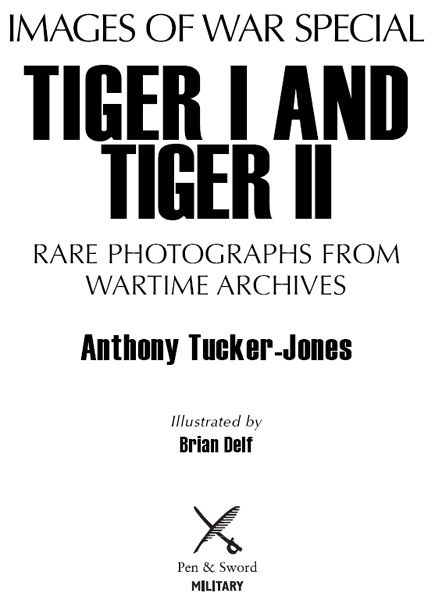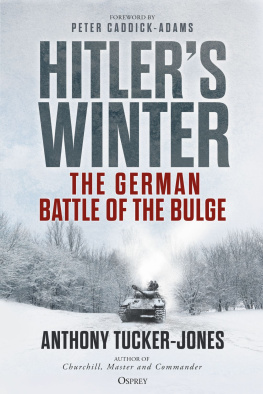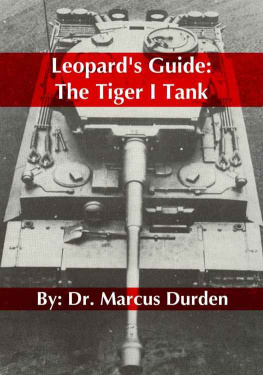

AGermanandaHungarianshareacigarettenexttotheimposingbulkoftheTigerII.

FirstpublishedinGreatBritainin2012by
PEN&SWORDMILITARY
animprintof
Pen&SwordBooksLtd,
47ChurchStreet,
Barnsley,
SouthYorkshire
S702AS
TextcopyrightAnthonyTucker-Jones2012
Photographscopyrightascredited2012
ColourillustrationsBrianDelf2012
PAPERBACKISBN:9781781590300
PDFISBN:9781473829282
EPUBISBN:9781473826786
PRCISBN:9781473826342
TherightofAnthonyTucker-JonestobeidentifiedasAuthorofthisWork
hasbeenassertedbyhiminaccordancewiththeCopyright,Designsand
PatentsAct1988.
ACIPrecordforthisbookisavailablefromtheBritishLibrary.
Allrightsreserved.Nopartofthisbookmaybereproducedortransmitted
inanyformorbyanymeans,electronicormechanicalincluding
photocopying,recordingorbyanyinformationstorageandretrievalsystem,
withoutpermissionfromthePublisherinwriting.
TypesetbyChicGraphics
PrintedandboundbyCPIGroup(UK)Ltd,Croydon,CR04YY
Pen&SwordBooksLtdincorporatestheImprintsof
Pen&SwordAviation,Pen&SwordFamilyHistory,Pen&SwordMaritime,
Pen&SwordMilitary,Pen&SwordDiscovery,WharncliffeLocalHistory,
WharncliffeTrueCrime,WharncliffeTransport,Pen&SwordSelect,Pen&
SwordMilitaryClassics,LeoCooper,ThePraetorianPress,Remember
When,SeaforthPublishingandFrontlinePublishing.
ForacompletelistofPen&Swordtitlespleasecontact
Pen&SwordBookslimited
47ChurchStreet,Barnsley,SouthYorkshire,S702AS,England
E-mail:
Website:www.pen-and-sword.co.uk
Contents
Introduction:HitlersZoo
ThisbooksetsouttocharttheremarkablestoryoftheTigerIandIItanks.Adolf
HitlersPanzerwaffe(panzerforce)namedmostofitstanksandarmouredfighting
vehiclesafterwildanimals,includingbigcats.TheTigertankswerenoexceptionandon
paper were war-winning designs. The name also conjures up an image of savagery and brutalkilling.Suchisitsfamethatifyouaskanyonetonameatank,theywillinevitably saytheTigerButfrankly,thoughitmightbeheresy,boththeTigerIandIIareoverrated.
In reality the Tigers were over-engineered, required raw materials that were in very shortsupply,weretime-consumingtoproduceanddifficulttorecoverfromthebattlefield.
Theywereveryheavy,notaltogetherreliableandvulnerableontheflanks.Evenso,their
thickarmourgavethemsurvivabilityandtheirmaingunenabledthemtostandoffandkill
their enemies with ease. It was these two traits that most frightened Allied tankers.
Nonetheless,despiteitslaterreputation,theTigerIsdebutinRussiaandTunisiawasfar fromauspicious.
The myth of the invincible Tiger has developed over time and it is often considered the deadliest tank of the Second world War. Certainly at the time British and American tankers developed Tiger anxiety. The reality is somewhat different: with only 1,354
Tiger Is and around 500 Tiger IIs ever built, they were never going to achieve anything morethanalocalimpactontheconductofthewarIncontrast,thePanzerMkIII/IV,M4
ShermanandT-34tankswereproducedinthetensofthousands.Almost6,000PanzerMk
V Panthers were manufactured, and this was an immediate contemporary of the Tiger VariantsoftheTigerwerebuiltinevenmorelimitednumbers:therewereonlyseventy-seven Jagdtigers, eighteen Sturmpanzers and ninety Jagdpanzer Elefants. Recovery
vehiclesconsistedofjustthreeBergepanzerTigerIsandthreeBergepanzerElefants.
WhenPen&SwordapproachedmetowriteanewprofileofthelegendaryTigertank,I
was somewhat hesitant. After all, what more can be said about what is easily the most famous(orinfamous)tankoftheSecondWorldWarItsstatusremainsundiminishedand
certainly,nomatterhowyoulookatit,theTigerwasatank-killerparexcellence.Ithas beencalculatedthatsome1,800Tigersaccountedforalmost9,000kills.
Everyschoolboygrowingupwithaninterestinmilitaryhistoryinvariablyendsupwith
amodelTigertankonhisshelves.ImustconfessIstillpossesstothisverydaya1/72
scaleAirfixTigerthatIbuiltwaybackinthe1970s.Thosewithaninterestinsuchmatters knowthatittookatleastthreeAlliedtankstoknockoutasingleTigerandthatitwasthe scourgeoftheAlliesinthebloodybattlesforNormandy.Therein,though,liesthefallacy of the Tigers fame: no matter how many Shermans or T-34 tanks it knocked out, the American,BritishandSovietarmiesalwayshadmore.
IsitpossibletoofferafreshperspectiveonthehistoryoftheTigertank?Forsuchan
iconictankitspositionisprettymuchunassailable.Phrasessuchasthesecrethistoryor
theuntoldstoryarehollowmarketingenticementsthatcropupwithregularmonotony.It
is, though, possible, by marshalling the evidence and technical assessments, to help re-evaluateperceptionsandindeedmisconceptionsoftheroleoftheTigerintheevolutionof armouredwarfare.
Allratherhighbrowperhaps,butthekeyquestionsarewherewasitdeployed,howwas
it deployed and what was its impact? Understand these and you can understand the contributionofanytank.Thiscanthenbeboileddowntoanevensimplerquestion:did
the tank fulfil the role it was intended for. Ultimately, the answer for the Tiger is a resoundingno,thoughsomemaybegtodiffer.
I first became closely acquainted with the Tigers capabilities through a very
longstanding fascination with the Normandy campaign and subsequently through an
interest with the campaigns fought in North Africa and on the Eastern Front. On closer inspection, it soon becomes apparent that the Tigers reputation is built upon its quite remarkabletacticalsuccessandnomore.Therecanbenodenyingthatthereweresimply
toofewTigerIsandevenfewerTigerIIstomakeadifferencetotheoutcomeofthewar.
In addition, the Tiger was designed as a heavy breakthrough tank and yet it ended up being used in environments that did not play to its strengths and increasingly in a defensiverole.
All the Tiger did was help slow down what, after the summer of 1944, was the inevitabledefeatofNaziGermany.IfHitlersfactorieshadhadthewherewithaltogearup to produce just Tiger tanks, then the Second World War might have turned out very differently.Therealityisthattheywereneverinapositiontodoso.
The German High Command without a doubt squandered its opportunities with the
Tiger.Ratherthanequipanentirepanzerdivisionwithit,theTigersweredissipatedinto piecemealpennypacketsamongtheGermanArmyandWaffen-SS.Becausetherewereso
few of them, they were formed into independent tank battalions that enabled a very powerfultacticalblow,butlackedagreaterstrategicpunch.
HitleralwayshisownworstenemycouldnotwaittogettheTigerintoactionand
pointlesslycommittedafewfirstatLeningradandtheninTunisia,wherethelocalterrain didnotallowittoplaytoitsstrengths.ItalsomeantthattheAlliessoonbecameawareof the presence of a new and formidable German panzer Similarly at the Battle of Kursk, whichisoftencitedastheTigersfinestmoment,againthereweretoofew.Likewisethe
impact of the subsequent Tiger II in Normandy, at the Battle of the Bulge and at Budapest/LakeBalatonwasverylimited.
ThepaucityandwastefuldeploymentoftheTigercausedrancouramongHitlerssenior
generals.GeneralHeinzGuderian,fatherofHitlerspanzerforcesandInspectorGeneral
ofArmouredForces,wasdismayedathowtheywerewastedatLeningradandinTunisia
thankstotheFhrersimpatience.Hewasveryvocalinhispost-warcriticismofHitlers
treatment of the Tiger In North Africa they became an issue of contention between GeneralsIrwinRommelandvonArniminthedyingdaysoftheNazifootholdinTunisia.
Next page





















